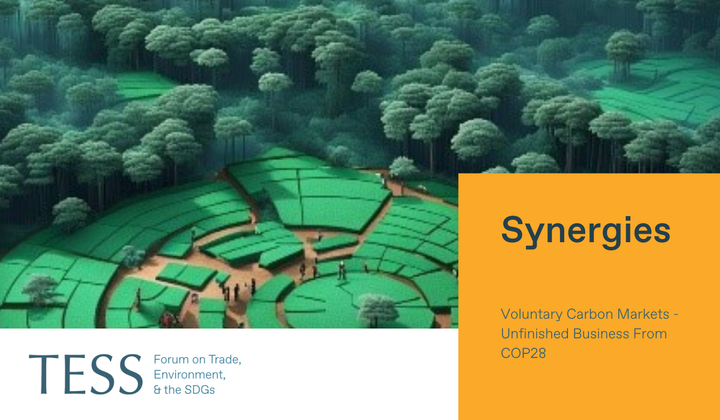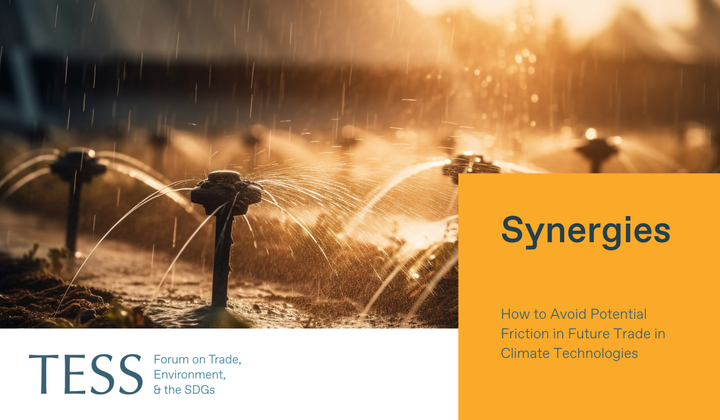As the International Maritime Organization considers the adoption of a carbon pricing mechanism, this article analyses the risk of World Trade Organization members challenging national or EU measures to implement or enforce such a mechanism. Overall, the risks of a successful challenge are low as only a few countries would be in a position to bring a challenge, and the grounds for challenging the measures would be very limited. However, these degree of risk will depend on how the instrument is designed and on the procedure used to adopt the pricing mechanism.
A previous version of this article first appeared as a guest post in the IELP Blog.
-----
International maritime transport is the lifeblood of the global economy, accounting for about 80 percent of international trade (by volume). In July 2023, the International Maritime Organization (IMO)—the UN agency that regulates international maritime transport—reached an agreement to reduce greenhouse gases (GHGs) from the sector. The resulting 2023 IMO Strategy on Reduction of GHG Emissions from Ships envisions making the sector climate-neutral by or around 2050 and includes relatively stringent GHG interim checkpoints for 2030 and 2040.
The IMO is now working on adopting a basket of measures to reduce GHGs in alignment with the new target. The basket of measures is scheduled for adoption in spring 2025 and is expected to include a GHG pricing mechanism (e.g. a GHG levy or a feebate scheme). If adopted, this could be the first global GHG pricing mechanism that is not simply an offsetting scheme.
The 2023 IMO Strategy on Reduction of GHG Emissions from Ships envisions making the international maritime transport sector climate-neutral by or around 2050, with a basket of measures expected to include a GHG pricing mechanism.
In a previous round of negotiations, India and Saudi Arabia made a submission to the IMO outlining possible incompatibilities of an IMO GHG pricing mechanism with World Trade Organization (WTO) law. Responding to a request by the IMO Secretariat, the WTO Secretariat then identified WTO law provisions that could be relevant in implementing an IMO GHG pricing instrument. To date, however, the WTO Secretariat has not provided a conclusive answer on the matter (perhaps not surprisingly).
In a recent article, I analysed the risk of WTO members challenging national or European Union (EU) measures to implement or enforce an IMO GHG pricing mechanism on the grounds that they violate GATT and GATS provisions.
Currently, several proposals are tabled for discussion at the IMO. Although the precise character of an IMO GHG pricing mechanism is yet to be determined, it is possible to make a preliminary assessment on the basis of these proposals. Below, I focus on three key questions.
Who could challenge national or EU measures to implement or enforce an IMO GHG pricing mechanism?
At the last round of IMO negotiations at the Marine Environmental Protection Committee (MEPC), IMO member states indicated a preference for adopting the IMO GHG pricing mechanism via an amendment of Annex VI of the International Convention for the Prevention of Pollution from Ships (MARPOL). If this path is followed, only countries that have not ratified MARPOL Annex VI would be in a good position to bring a challenge, as normally countries cannot challenge measures adopted to implement or enforce a convention they have ratified. As of May 2024, 70 countries have not ratified MARPOL Annex VI. Of these, very few have a history of bringing disputes to the WTO.
Note that vessels and goods of countries from non-MARPOL Annex VI countries would (most likely) still be subject to the IMO GHG price because the IMO tends to operate based on the “no more favourable treatment” (IMO NMFT) clause, according to which port states under an IMO convention will apply the convention also to vessels registered in countries not part of that convention.
Usually, the IMO tries to operate on a consensus basis. However, when consensus cannot be reached, IMO member states can decide through a voting procedure. In previous negotiations, GHG measures were adopted despite China, Chile, Brazil, Kuwait, and Saudi Arabia voting against them. If the GHG pricing mechanism is adopted through a voting procedure, the countries that oppose its adoption may try to bring a WTO challenge. However, their position would be weak, as they have accepted to be bound by the procedural rules for amending MARPOL Annex VI.
If the IMO GHG pricing mechanism is adopted through a new convention (which looks unlikely at this point), the number of countries that could bring a challenge is difficult to predict, as it depends on the number of countries that ratify the convention.
What GATT and GATS provisions could be violated by national or EU measures adopted to implement or enforce an IMO GHG pricing mechanism?
Based on the current proposals tabled for discussion at the IMO, there are few potential ways in which national or EU measures could violate GATT or GATS provisions. A key reason for this is that all these proposals envision that the GHG price will be paid by vessels directly into an international fund without being levied by the port or flag state. Because of this feature, many of the provisions identified by the WTO Secretariat as potentially relevant for developing an IMO GHG pricing mechanism are unlikely to apply. These include GATT Article I:1, GATT Article III:2, and GATT Article VIII.
Based on the current proposals for a GHG pricing mechanism tabled for discussion at the IMO, there are few potential ways in which measures implemented by WTO members could violate GATT or GATS provisions.
Research indicates that a GHG pricing mechanism could reduce the profitability of shipping companies. One of the critical points of contention in IMO negotiations on a GHG pricing mechanism is whether the price should apply universally (i.e. to all emissions from vessels of a specific size or larger) or only to ships that do not meet a pre-established GHG fuel intensity target. The GHG fuel intensity of the fleet of different countries may vary systematically, depending on the type of vessels and routes covered (on some routes, zero and near-zero GHG bunker fuels may be less available than on others). Potential negative impacts of the GHG pricing mechanism on the fleet of different countries may vary depending on how the GHG fuel intensity target is set. Countries could question how such a target was chosen and bring a challenge for violation of most favoured nation (MFN) under the GATS. Measures that implement or enforce a universal GHG pricing mechanism are less contestable as they apply the same price per tonne of GHG.
In IMO, the GHG pricing mechanism will also increase the price of goods traded by sea. While potentially low on average, impacts will likely be uneven, with high-weight, low-value goods and countries less well-connected with their export markets likely to be negatively impacted more. Work is ongoing at the IMO to quantify such impacts. To the extent that some countries are impacted more than others, they may argue that measures that implement or enforce the GHG pricing mechanism violate Article XI:1 GATT (quantitative restrictions on imports/exports).
Any potential violation of MFN under the GATS and Article XI:1 GATT could be justified under Article XIV GATS and Article XX GATT. In this respect, the GHG pricing mechanism should be, inter alia, designed to be climate-effective and have the lowest possible trade restrictiveness. To this end, a share of the significant revenues that could be raised through the GHG pricing mechanism (up to 40–60 billion US dollars a year until 2050) could be used to reduce disproportionately negative impacts on states.
If exemptions are included in the design of the GHG pricing mechanism, would national or EU measures adopted to implement or enforce it become easier to challenge?
Some IMO member states—including China, Brazil, and Argentina—proposed a GHG pricing instrument that is less stringent for vessels that call at ports of certain developing countries. This adjustment would result in lower or no payment made by vessels that serve the selected ports. This feature of the proposal is meant to help address equity-related concerns in the energy transition of shipping, such as avoiding disproportionately negative impacts on developing countries.
Including a partial exemption of this type in the GHG pricing instrument will likely make national or EU measures that implement or enforce it more susceptible to a successful challenge under the GATT and the GATS for two reasons. On the one hand, such exemptions could be infringing the MFN principle under the GATS. On the other hand, exemptions (even partial ones) risk undermining the climate effectiveness of the GHG pricing instrument. Besides lowering the climate stringency of the instrument overall, they also risk enabling avoidance opportunities for vessels.
The GHG effectiveness of the instrument is one of the criteria for the applicability of the justifications under Article XIV GATS and Article XX GATT. Deep and broad exemptions that severely undermine the instrument’s environmental integrity would not be easily reconcilable with these justifications. Furthermore, despite calls to change this approach, WTO jurisprudence tends to equate differentiation with discrimination under Article XX GATT.
Equity-related considerations might be better addressed via the use of revenues from the GHG pricing mechanism. These revenues can be substantial and could provide a new and additional source of climate finance.
In the IMO context, the least developed country (LDC) waiver is unlikely to be helpful in implementing exemptions for LDCs. There are various reasons for this, including the fact that the waiver would likely apply only to a share of the fleet registered in LDCs. In addition, such a waiver would contravene the IMO NMFT clause. Similarly, the enabling clause is unlikely to help implement exemptions for LDCs. If vessels pay the GHG price directly into a fund periodically, Article I GATT is unlikely to apply.
In this context, equity-related considerations might be better addressed via the use of revenues from the GHG pricing mechanism, as argued in IMO negotiations by various countries—including Belize and many Pacific small island developing states (SIDS)—and the World Bank. As mentioned above, these revenues can be substantial and could provide a new and additional source of climate finance. In a recent World Bank report, my co-authors and I have proposed a framework to use revenues to enable an effective and equitable transition.
-----
Goran Dominioni is Assistant Professor at the School of Law and Government, Dublin City University.
-----
Synergies by TESS is a blog dedicated to promoting inclusive policy dialogue at the intersection of trade, environment, and sustainable development, drawing on perspectives from a range of experts from around the globe. The editor is Fabrice Lehmann.
Disclaimer
Any views and opinions expressed on Synergies are those of the author(s) and do not necessarily reflect those of TESS or any of its partner organizations or funders.
License
All of the content on Synergies is licensed under a Creative Commons Attribution-NonCommercial-ShareAlike 4.0 International (CC BY-NC-SA 4.0)
license. This means you are welcome to adapt, copy, and share it on your platforms with attribution to the source and author(s), but not for commercial purposes. You must also share it under the same CC BY-NC-SA 4.0 license.
If you would like to reuse any material published here or if you have any other question related to Synergies, send an email to fabrice.lehmann@graduateinstitute.ch.




